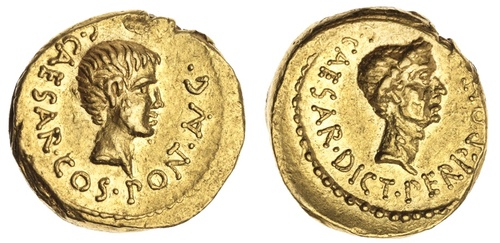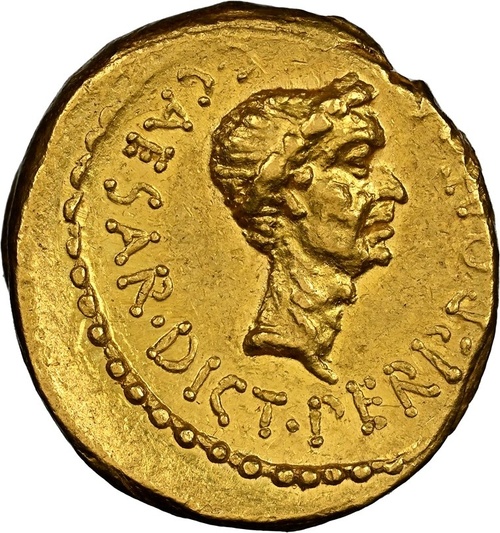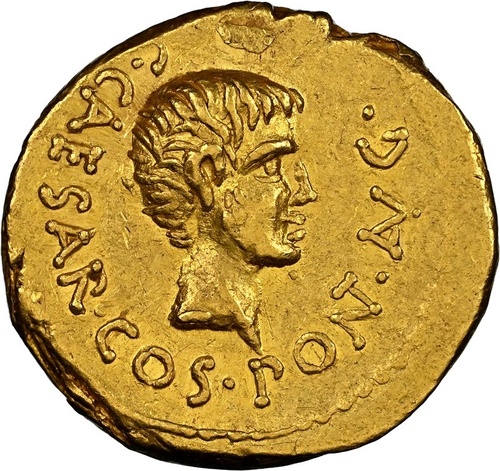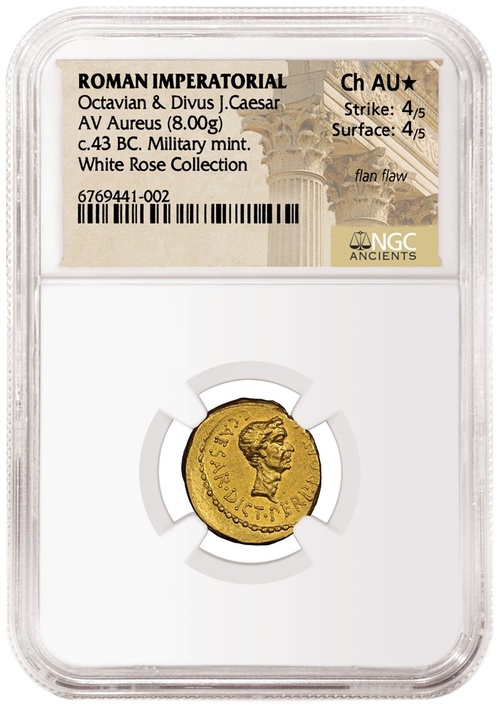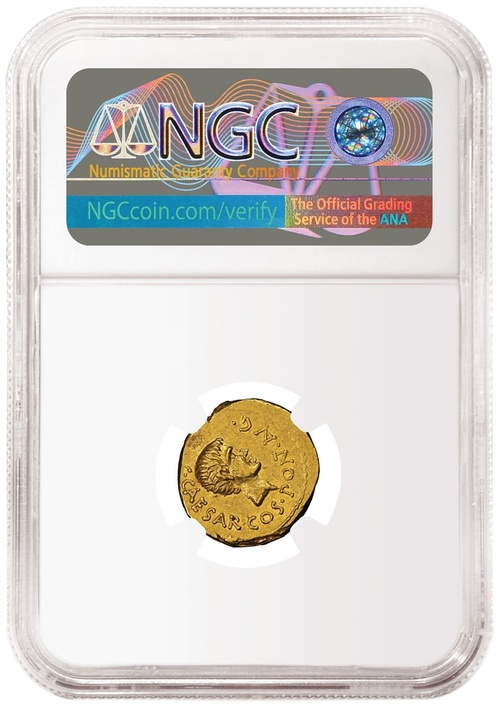Auction: 23004 - Ancient and British Coins - Featuring the 'White Rose' Collection
Lot: 636
NGC Choice AU* | Roman Imperatorial, Gaius Julius Caesar Octavianus, as Consul, Julius Cæsar, as Dictator Perpetuo and Pontifex Maximus, AV Aureus, struck July-August 43 BC, Military Mint with Octavian in Transalpine and Cisalpine Gaul after the Battle of Mutina,
Provenance
Believed to be:
A E Harvey, Glendining, 15 April 1937, lot 186 - "mint state, but imperfectly struck along one edge, very rare" - £18.10.0
This issue belongs to the short period after the Second Battle of Mutina on 21 April 43 BC, at which time Octavian would be "recognised" as Rome's consul and prior to the formation of the political triumvirate in the Autumn of the same year. Divus Cæsar is depicted wearing a gold wreath as in life and he would not be officially deified until early in 42 BC.
Caesar'z death bought his unanticipated heir Octavian into direct opposition with Marc Antony almost immediately; for both could present themselves as Caesar's legitimate political successor. Octavian, as Caesar's heir, could weaponise his adopted family name - a facet he used from his coin productions whilst on campaign in Cisalpine Gaul (RRC 490/1-4) and of which this present coina was his first to be sanctioned in gold. Octavian demonstrated his shrewd political knowledge by seeking to imitate the coinage of his adversary and then more lauded rival Antony, by also issuing a double portrait coin. This issue (RRC 490/2), which clearly emphasises his direct kinship with Caesar 'the Martyr' depicts an adolescent Octavian bearded in demonstration of his mourning. The reverse carries a laureate and life-time or even 'death mask' veristic portrait of the late Julius Caesar. The iconographic portrait renderning is clearly purposed to familiarise the two men in the mind of the coin's possessor, amongst whose earliest recipients would have been the Legions whose loyalty had shifted to Octavian from Caesar on the latter's untimely demise. The similarities of the two legends clearly aid this design yet further - C CAESAR COS PONT AVG and C CAESAR DICT PERP PONT MAX.
Traditionally this issue has been dated as late as 40 BC, but both Crawford and Newman have demonstrated, as the legends would imply, that this wonderful Aureus was issued considerably earlier and almost immediately following the Senate's campaign against Mark Antony in the Mutinensian War. When both existing consuls Aulus Hirtius, who had previously struck coins with Julius Caesar (see lot 635) and Gaius Vibius Pansa Caetronianus died in the fighting. Octavian demanded the consulship for himself. but his request was declined at least twice. With his notorious unscrupulousness, Octavian marched against the capital with his veteran legions, seizing it in July/August 43 BC and enforcing his appointment to consul suffectus.
These dramatic events marked a turning point in Octavian's career. Having initially fought for the Senate's cause, Caesar's grand-nephew now turned against it. While his role in the defeat of Mark Antony in the Spring of 43 had certainly increased his reputation, his legitimacy was still far from being undisputed. The striking of a coinage with his portrait and that of his adoptive father made it clear to the world that the young and ambitious Octavian saw himself as the rightful heir to the murdered dictator, sending a clear message to the Senate, to Mark Antony, and most importantly, to Caesar's veterans, many of which had been serving on opposite sides in the Civil War.
Following the capture of Rome, Octavian would soon reconcile with Antony and form the Second Triumvirate that Autumn, the third member of which being Marcus Aemilius Lepidus. This agreement between the three powerful men resulted in a de facto military dictatorship and the ultimate defeat of Caesar's murderers Marcus Junius Brutus and Gaius Cassius Longinus in the Battle(s) of Philippi in 42 BC. With Lepidus gradually loosing influence in the following years, the stage was eventually set for the mightiest clash of titans, between Octavian and Mark Antony in 32-30 BC. The countdown to Empire had begun.
Subject to 20% VAT on Buyer’s Premium. For more information please view Terms and Conditions for Buyers.
Sold for
£220,000
Starting price
£50000

